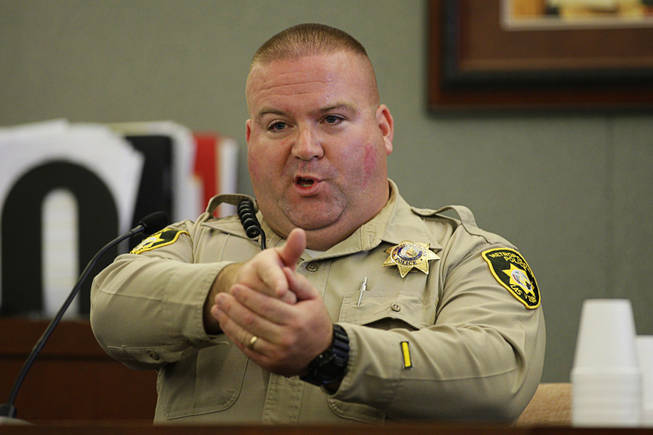
Metro Police Officer William Mosher testifies about shooting Erik Scott during a coroner’s inquest at the Regional Justice Center Thursday, September 23, 2010.
Thursday, Sept. 23, 2010 | 8:36 p.m.
Audio Clip
- Shai Lierley on the phone with dispatchers
-
Audio Clip
- Unidentified caller from within Costco talking to dispatchers
-
Audio Clip
- Metro Police radio traffic during the July 10 officer-involved shooting that left Erik Scott dead
-
William Mosher was one of the first Metro Police officers who responded to the Summerlin Costco on July 10 after an employee called 911 to report that a man with a concealed weapon was destroying merchandise in the store and acting erratically.
As customers were exiting the warehouse shopping club, Mosher, with his gun drawn, watched the entryway.
The employee who had called 911, 33-year-old Shai Lierley, was walking behind the man, later identified 38-year-old Erik Scott.
Seeing the officer, Lierley flagged Mosher down, pointed at Scott and said, “That’s him,” Mosher testified.
Mosher, describing what happened next, said he waved several citizens out of the way. Holding his gun to his chest, he told Scott to turn around; as he did so, Mosher saw the gun in Scott’s waistband.
Mosher said he yelled several commands.
He saw that Scott’s eyes looked bloodshot.
He noticed that Scott appeared to be “out of it.”
He heard Scott say, “I have a gun.”
When he saw that gun “come up,” the five-year Metro veteran fired two rounds. Two other officers also fired, ultimately hitting Scott with seven bullets. Five went into his back.
Mosher’s testimony came as part of the second day of a coroner’s inquest into the death of Scott, a West Point and Duke University graduate who was working as a medical salesman.
Prior to the shooting, Mosher said, he had been told over the police radio that Scott had said he was a Green Beret, had been acting erratically, was throwing merchandise around, appeared to be high on narcotics, had a gun and would not leave the store.
Mosher said the fact that Scott was a Green Beret concerned him as he was driving toward the store because he knew Scott would be trained to use small arms.
He said he was further concerned because if Scott was lying about being a Green Beret, it could mean mental issues were a factor in his reported behavior.
Mosher also said he was worried because it was a busy Saturday afternoon and 1,000 people could be at the store.
Several witnesses testified on Wednesday that they believed Scott was addicted to narcotic painkillers and said he was suffering from depression.
During proceedings Thursday, two recordings of 911 calls were played for the jury. One of those calls was made by Lierley, a Costco loss prevention supervisor.
Lierley was on the witness stand while the call was played and explained to the jury what had led him to call police.
He said Scott was acting “erratically” in an aisle, pacing back and forth, mumbling to himself.
Lierley said he began watching Scott for a few minutes as he was putting steel bottles into a neoprene bag, tearing them from their cardboard containers.
He said he eventually noticed Scott had a firearm in his waistband, so he and another employee approached Scott and told him Costco had a policy against firearms in the store and he would have to take the gun outside.
“I’m a Green Beret. You need to read the (expletive) Constitution,’” Lierley said Scott told them. “He was angry. He snapped up real quick.”
Lierley also said Scott said he had a constitutional right to carry the gun.
However, Lierley said that Scott did not threaten anyone inside the store; didn’t act violently; and didn’t remove the gun from his waistband. Scott did touch the weapon several times as he walked around the store, Lierley said.
Lierley also testified he was aware that the video recording system at the store wasn’t working. He had contacted Vegas Valley Locking Systems, the local company that provides technical support for the surveillance system, the Wednesday before the shooting. A repair appointment had been scheduled for the following Monday.
Much of the testimony Thursday afternoon honed in on the technicalities surrounding the faulty hard drive that the cameras were supposed to be recording onto.
A Metro forensic multimedia analyst, Brian Wyche, testified that he went to Costco the day of the shooting and was unable to recover any data from the hard drive.
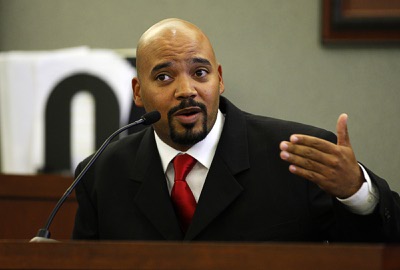
Brian Wyche, a forensic multimedia analyst for Metro Police, testifies during a coroner's inquest for Erik Scott at the Regional Justice Center Thursday, September 23, 2010. Scott was shot and killed by Metro Police Officers at the Summerlin Costco store on July 10. Wyche said he couldn't find video files from interior cameras recorded for that day on the Costco surveillance system.
Jason Swords, of Vegas Valley Locking Systems, said the device was brought to his office July 12 so he could further attempt to recover data but said he was unsuccessful.
Metro sent the device, by way of the Los Angeles Secret Service, to Seagate Recovery Systems in Santa Clara, Calif.
David Teigen, who works for the company, testified that on the one-terabyte drive, 600 gigabytes of data were recovered. Much of the data was corrupted, he said. Peter Calos, a Metro homicide detective who was conducting the investigation into the shooting, played some of the video that was recovered for the jury.
The video played shows that a camera zeroed in on the front doors of Costco, where the fatal shooting occurred, was active until it crashed about 2:14 p.m. on July 8, two days before the shooting.
“This is when the internal drive system fails,” Calos said as the screen went dark.
The camera didn’t record any events from that time until the system was rebooted about 5:30 p.m. on July 10, after the shooting took place, he said.
Wyche testified that he had restarted the machine that day when he was attempting to recover the files.
What was shown was video of the parking lot at about the time of the shooting.
Calos said the video showed the first patrol car pull into Costco. But he said the angle of the camera doesn’t show the doors of the building, which is where the fatal shooting took place.
People are seen running away from the store and into the parking lot at a time that would be in accordance with when shots were fired; however, no footage of the actual shooting, outside the front doors, or from inside the store the day of the shooting exists, Calos said.
He explained how after homicide detectives responded to the scene and began investigating the officer-involved shooting, a number of items were recovered outside the store: Several shell casings, a cell phone, and a 9mm Kimber semiautomatic handgun.
The handgun was still in its holster.
Mosher testified that he didn’t know that the gun was in its holster at the time he fired. He said he owns the same type of holster, and the gun could be “easily fired” while in its holster.
He also testified that he didn’t recall ordering Scott to “drop his gun.” But those commands are distinctly heard on the 911 tape that was played for the jury.
The tape was again played for Mosher, who said it was his voice on the tape. He was the only officer issuing commands, he said.
The following is heard in the 911 call: “Put your hands where I can see them now. Drop it! Get on the ground! Get on the ground!”
“He refused to comply with those commands, to show his hands, or to get on the ground,” Mosher testified.
Scott responded by pulling out his gun, Mosher said. Mosher saw the gun being raised in his direction.
"He was a deadly threat with that weapon in his hand," Mosher said.
Mosher said at that point, fearing for his own safety, fearing for the safety of the other officers and fearing for the safety of the crowd, "I fired my weapon at center body mass."
After Mosher’s two shots hit Scott, Scott took a few steps back and the other officers fired.
“He staggered back several more feet, turned around, then fell on his face,” Mosher testified.
He also told the jury about a 2006 shooting during which he fatally shot a man who was a suspect in a home invasion.
Mosher said he and his partner responded to a call about a robbery in progress. After giving chase to the suspect on foot, the man was able to get in his car. Mosher said his backup partner, also on foot at that point, wound up on the ground. Mosher said he believed the man, who had already rammed into a patrol car, was going to run over and kill his backup officer.
As the man was reaching under the front seat of the car, possibly to retrieve a weapon, Mosher shot and killed him, he said.
A coroner’s jury found him to be justified in that instance.
Steven Novotny was the first person to testify Thursday morning. He said Scott pulled a gun on his dog on March 9 this year. Novotny said the dog had bitten Scott.
“Mr. Scott said, ‘You’re lucky I didn’t shoot you and your (expletive) dog,’” Novotny testified.
Novotny said Scott was pointing his gun at Novotny when the incident occurred. He said he then went to confront Scott about what happened and that he wasn’t fearful about the confrontation “because I was also carrying.” At that time, Novotny was unable to find him, he said.
Scott complained to animal control, which quarantined the dog for several days. Novotny filed a report with police about Scott threatening him with a gun.
Novotny said he later ran into Scott in a parking lot and offered to pay for Scott’s hospital bill from the dog bite, but Scott left.
A coroner’s inquest is a fact-finding procedure designed to determine the facts surrounding police officer-involved deaths. Jurors determine whether the shooting was justifiable, excusable or criminal and do not have to be unanimous in reaching their verdict.
Scott’s family has been openly critical of the inquest process. Following Thursday’s proceedings, their attorney, Ross Goodman, spoke with reporters about Mosher’s testimony.
“What you heard today was the best that the state has to offer. They cherry picked their witnesses,” Goodman said. “And officer Mosher said a .45-caliber gun was in the holster on the ground.”
“So how could he have pulled his gun out and pointed it at anybody? In fact, what you heard today is that Erik Scott was leisurely walking out. He wasn’t posing a threat to anybody; he didn’t make any aggressive movements.”
Goodman said that Mosher didn’t remember what he instructed Scott to do until he was reminded by the prosecutor with the audio of Lierley, who was telling a 911 dispatcher what was happening.
“In fact, he instructed Erik Scott to drop the gun,” Goodman said. “So Erik Scott apparently took out the holster with the gun in it and it fell on the ground.
“Mosher’s going to remember whatever he wants to remember. The fact of the matter was that Erik Scott was surrounded by three officers. He turned around. He was compliant, according to officer Mosher. He was told to drop the gun and he did exactly that.”
Mosher, 38, has been with the department since June 2005. Other officers involved in the shooting are Joshua Stark, 28, with the department since September 2008, and Thomas Mendiola, 23, with the department since March 2009.
Proceedings are set to resume at 8 a.m. Friday.
Sun Archives
- Family critical of process as inquest into police shooting set to start (9-16-2010)
- Attorney for family in police shooting calls inquest process ‘a farce’ (9-16-2010)
- Attorney in Erik Scott case sends letter to judge over evidence (9-16-2010)
- Erik Scott’s family asks to view evidence before inquest (9-9-2010)
- Inquest into police shooting to be broadcast on cable TV (9-7-2010)
- Inquest set for Sept. 22 in police Costco shooting (8-12-2010)
- Metro mails Costco customers to find witnesses in police shooting (8-18-2010)
- Candlelight vigil held in memory of man killed by Metro Police (8-11-2010)
- Planning for a situation like recent Costco shooting not easy for police (7-19-2010)
- Man killed by police in Costco shooting honored at memorial (7-17-2010)
- Metro IDs officers in fatal shooting at Summerlin Costco (7-12-2010)
- Officers fatally shoot armed man at Summerlin Costco (7-10-10)
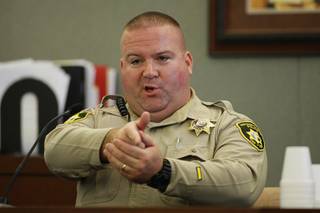
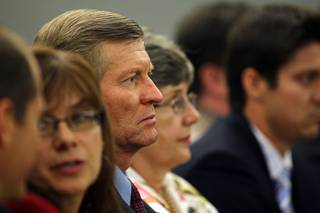
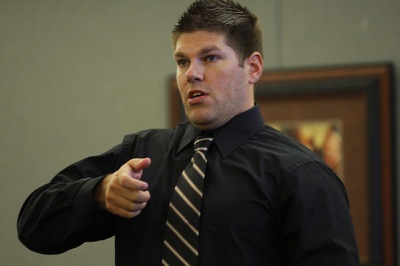
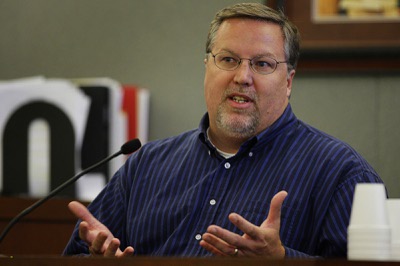
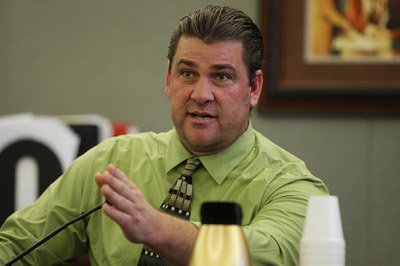
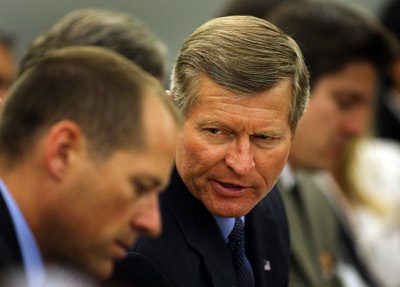

Join the Discussion:
Check this out for a full explanation of our conversion to the LiveFyre commenting system and instructions on how to sign up for an account.
Full comments policy